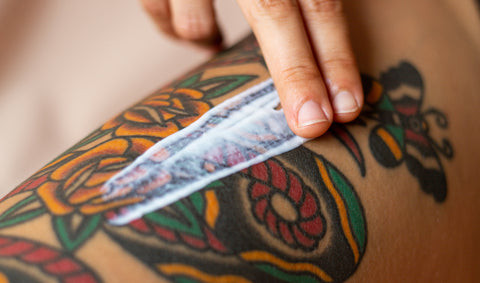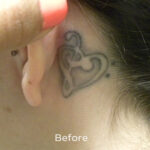Getting a new tattoo is an exciting experience, and once you’ve got your fresh ink, one of the first questions that pops into your mind is likely: “how long is this going to take to heal?”. Understanding the tattoo healing process is crucial for ensuring your artwork looks its best and avoids any complications. Tattoo healing isn’t a quick process; it’s a journey with different stages, and knowing what to expect at each stage will help you care for your new tattoo effectively.
Understanding the Tattoo Healing Timeline
Tattoo healing is not linear, but rather progresses through several distinct stages. While everyone heals at slightly different rates, there’s a general timeline you can expect your tattoo to follow. Understanding these stages will help you navigate the healing process with confidence.
Initial Days: What to Expect Immediately After Getting Inked
In the first few days after getting your tattoo, it’s essentially an open wound. Your body immediately starts the healing process. Expect your tattoo to be tender, slightly swollen, and possibly oozing a bit of blood and ink mixed with plasma. This is completely normal. During this initial phase, keeping the tattoo clean and protected is paramount. Your tattoo artist will usually apply a bandage orSaniderm to protect the fresh tattoo. This initial covering helps to prevent bacteria from entering the wound and keeps it moisturized.
 Woman with tattoos smiling
Woman with tattoos smiling
The Scabbing Stage: How Long Does Scabbing Typically Last?
Scabbing is a common and natural part of tattoo healing. As Barbara Crane, content manager at Stories & Ink, explains, “To me it just seemed normal as it’s technically a wound that needs to heal, so scabs made perfect sense.” Scabs form to protect the wound from infection while the skin underneath repairs itself. The scabbing phase typically begins within a few days of getting your tattoo and can last for about a week to ten days.
The thickness and duration of scabbing can vary. Factors like the size and style of the tattoo play a role. For instance, tattoos with heavy shading or larger areas of color are more likely to develop thicker scabs compared to fine-line tattoos. Barbara notes, “If it’s just line work, then the scab is usually minimal and comes off like dry skin. But, if it’s been heavy shading, the scabs can be thicker and don’t come off as fast.”
Peeling and Flaking: A Sign of Progress
After the scabbing phase, you’ll likely notice your tattoo starting to peel and flake, similar to a sunburn. This is a positive sign that your skin is regenerating and pushing out the damaged outer layers. Itchiness is common during this stage, but it’s crucial to resist the urge to scratch or pick at the peeling skin. Letting the skin peel naturally prevents damage to the healing tattoo and reduces the risk of scarring or ink loss. This peeling stage can last for another week or two as the outer layers of skin continue to shed.
The Final Stages: When is Your Tattoo Fully Healed?
While the visible scabbing and peeling might subside within 2-3 weeks, the tattoo healing process is not fully complete at this point. Deep within the dermis, your skin is still repairing and regenerating. The entire tattoo healing process can take anywhere from 2 to 4 weeks, and in some cases, even up to 6 months for the deeper layers of skin to fully regenerate and settle.
During the later stages of healing, the tattoo might appear slightly cloudy or milky. This is because a layer of dead skin cells is still present over the tattoo. As the skin fully regenerates, the colors will become more vibrant and the tattoo will reach its final appearance. Even after the visible healing signs are gone, it’s still essential to continue moisturizing and protecting your tattoo to maintain its vibrancy and longevity.
Factors Influencing Tattoo Healing Time
Several factors can influence how long your tattoo takes to heal. Understanding these elements can help you anticipate the healing duration and take appropriate care.
Tattoo Size and Complexity
Larger and more intricate tattoos naturally take longer to heal than smaller, simpler designs. Tattoos with extensive shading, heavy lines, or multiple colors involve more trauma to the skin, requiring a longer recovery period. Conversely, small, minimalist tattoos with fine lines tend to heal relatively quickly.
Tattoo Placement Matters
The location of your tattoo significantly impacts healing time. Areas of the body with more friction or movement, such as hands, fingers, feet, and joints, tend to heal slower. Barbara recalls, “I remember I got a scab on my finger tattoo as late as one week after visiting my artist, since tattoos in that area heal very slowly.” Areas with less friction and tighter skin, like the forearm or thigh, often heal faster. Proper aftercare is especially crucial for tattoos in challenging locations.
Individual Healing Rates and Health
Everyone’s body heals at its own pace. Factors like age, genetics, immune system strength, and overall health play a significant role in tattoo healing time. Younger individuals with robust immune systems often heal faster. Conditions that compromise the immune system or circulatory issues can slow down the healing process. Maintaining a healthy lifestyle, including proper hydration, nutrition, and rest, can support optimal healing.
The Crucial Role of Aftercare
Proper aftercare is arguably the most critical factor in determining how quickly and effectively your tattoo heals. Following your tattoo artist’s aftercare instructions diligently can significantly expedite healing and prevent complications. Conversely, neglecting aftercare or engaging in activities that hinder healing can prolong the process and increase the risk of infection or scarring.

Recognizing Signs of Improper Healing or Infection
While scabbing and peeling are normal, it’s important to distinguish between healthy healing and signs of potential complications, such as infection. Being vigilant and recognizing abnormal symptoms is crucial for protecting your tattoo and your health.
Normal vs. Abnormal Scabbing
Normal tattoo scabbing is typically thin and the color of dried lymph fluid or ink. It should not be excessively thick, raised, or excessively painful. Abnormal scabbing, however, can indicate a problem. Signs to watch out for include:
- Excessively thick or raised scabs: These can be a sign of trauma or improper healing.
- Scabs that are yellow or greenish: This could indicate infection.
- Scabs accompanied by excessive redness, swelling, or heat: These are also potential signs of infection.
Symptoms of Tattoo Infection: When to Seek Help
Tattoo infections are relatively rare but can occur if proper hygiene and aftercare are not followed. It’s important to be aware of the symptoms of an infected tattoo and seek professional help if you suspect an infection. According to Barbara, “there are a few things to watch out for that can suggest an infection”. These include:
- Increased pain or tenderness: While some discomfort is normal, escalating pain can be a warning sign.
- Excessive redness and swelling: Redness that spreads beyond the immediate tattoo area or significant swelling is concerning.
- Pus or drainage: Discharge that is yellow, green, or foul-smelling is a clear indication of infection.
- Fever or chills: Systemic symptoms like fever can accompany a tattoo infection.
- Red streaks radiating from the tattoo: This can be a sign of spreading infection and requires immediate medical attention.
- Unusual hardening of the skin around the tattoo.
If you experience any of these symptoms, consult your tattoo artist or a medical professional promptly. Early intervention is key to treating tattoo infections effectively and preventing complications.
Essential Aftercare Tips for Faster Tattoo Healing
Proper aftercare is the cornerstone of successful tattoo healing. By following these essential dos and don’ts, you can promote faster healing and ensure your tattoo looks its best for years to come.
Dos and Don’ts for Tattoo Aftercare
Do’s:
- Leave it alone: Allow your body to heal naturally. Resist the urge to pick, scratch, or touch your tattoo unnecessarily.
- Keep it clean: Gently wash your tattoo twice daily with mild, fragrance-free soap and water.
- Moisturize: Apply a thin layer of tattoo-specific aftercare cream or a fragrance-free, hypoallergenic moisturizer to keep the tattoo hydrated. Stories & Ink Aftercare Cream is a great option.
- Stay hydrated: Drink plenty of water to support overall skin health and healing.
- Wear loose clothing: Avoid tight clothing that can rub against your new tattoo and cause irritation.
- Protect it from the sun: Once healed, always use sunscreen on your tattoo to prevent fading and damage.
- Shower, but avoid prolonged soaking: Short showers are fine, but avoid baths, swimming pools, and hot tubs until your tattoo is fully healed.
- Consult your artist: If you have any concerns or questions about your healing tattoo, don’t hesitate to reach out to your tattoo artist for guidance.
Don’ts:
- Don’t pick or scratch: Picking at scabs or peeling skin can lead to scarring, ink loss, and infection.
- Don’t over-moisturize: Applying too much moisturizer can trap moisture and hinder healing. A thin layer is sufficient.
- Don’t use harsh soaps or lotions: Avoid products with fragrances, dyes, or harsh chemicals that can irritate the tattoo.
- Don’t soak your tattoo: Submerging your tattoo in water for extended periods can interfere with healing and increase the risk of infection.
- Don’t expose your tattoo to direct sunlight: Sunlight can damage a healing tattoo and cause fading.
- Don’t work out excessively: Avoid strenuous activities that cause excessive sweating in the first few days.
- Don’t listen to unqualified advice: Stick to your tattoo artist’s aftercare instructions and reputable sources for information.

Product Recommendations
Choosing the right aftercare products can make a significant difference in your tattoo’s healing journey. Stories & Ink offers a range of aftercare products specifically designed for tattoos. Barbara recommends using “the right kind of soap, like the Aftercare Foam Cleanser, so there’s no bad bacteria buildup that can lead to infection.” Following up with “Aftercare Cream” can help when the tattoo gets “too dry or too itchy”.
Using a dedicated tattoo aftercare duo, like the Stories & Ink Aftercare Duo, can simplify your aftercare routine and provide your tattoo with the optimal environment for healing. These products are often formulated to be gentle, fragrance-free, and contain ingredients that promote healing and reduce inflammation.
Conclusion
Understanding how long tattoos take to heal involves recognizing the different stages of healing, being aware of influencing factors, and committing to diligent aftercare. While the initial scabbing and peeling phase may resolve within a few weeks, complete healing can take longer. Patience and consistent aftercare are key to ensuring your tattoo heals beautifully and remains vibrant for years to come. By following the guidelines outlined and listening to your body, you can navigate the tattoo healing process with confidence and enjoy your stunning new artwork.
